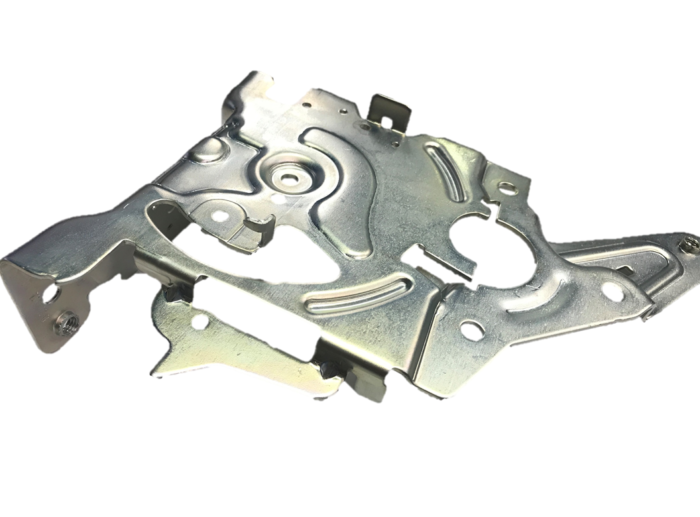ZINC PLATING PRODUCT INFO
DeKalb Metal Finishing provides zinc electroplating services with a focus on the automotive industry. We provide customers with quality alkaline zinc plating by combining nanotech based chemistry with industry leading process control equipment. No matter the complexity, we have the capability to provide excellent results.
OUR ZINC PLATING PROCESS
At DeKalb, we utilize a zinc plating process that offers a significant advancement in the technology of non-cyanide zinc plating. A remarkable feature of our process is that it offers extremely high levels of corrosion resistance without depositing excessive thickness.
Zinc plating can be applied with either a thin or thick film RoHS compliant passivate in order to achieve the customers objectives. Some specs, such as Ford WSS-M1P85 and ISO 19598 specifically call out the use of a thin film passivate over zinc plating while other specs such as GMW3044, FCA PS.50036, HES D 2003, and TSH6524G do not. Thin film passivates are used when corrosion requirements are low, when parts will be processed with a secondary coating after plating (e.g. e-coat or powder coat), or when the plating is being used as a base coating prior to the application of primer and adhesive. Thick film passivates are used when maximum corrosion resistance is the primary objective.
Customers looking for a bondable rubber to metal application will find that our zinc plating acts as an ideal base, is receptive to primer and adhesive, and offers a high level of corrosion resistance.
Zinc plating deposits can also withstand 120° C (248° F) as a continuous service temperature.
PRODUCT BENEFITS OF ZINC PLATING
– Extraordinary ability to achieve better than a 2:1 high / low thickness distribution ratio
– Minimum thickness can be achieved without building excessive thickness in high current density areas
– Plating deposits are clear, fine grained, and burn free even at high current densities
– Deposits are designed to be “zero-stress” to eliminate latent blistering due to the electrolyte
– Durable, lightweight, and strong
– Eco-friendly, natural element that can be infinitely recycled without losing any of its properties
– Cost effective way of protecting the substrate while significantly reducing possibility of material corrosion
– Deposits are extremely ductile making post plating forming operations possible
– Offers adhesive properties making it an effective undercoat to e-coating or painting while improving corrosion resistance

WHAT MAKES ZINC IDEAL FOR CORROSION PROTECTION
Zinc plating is often preferred for coating iron and steel parts when protection from either atmospheric or indoor corrosion is the primary objective. Electroplated zinc without subsequent treatment becomes dull gray in appearance after exposure to air. Bright zinc that has been subsequently passivated is sometimes used as a decorative finish.
Metal plating companies like DeKalb Metal Finishing often call zinc a sacrificial coating as it sacrifices itself to protect the substrate underneath. The method used to apply the zinc coating to the component is called electroplating which simply means running a current of electricity through a saline/zinc solution with a zinc anode and steel conductor. Through a process called electro deposition, a product is dipped in a bath containing zinc, a current is applied, the zinc dissolves, and the freed metal ions of the zinc reach the product’s cathode to thinly form a coating.
ZINC PLATING PASSIVATION PROCESS AND COLORS
Passivation is the process of making the parts “passive” or less easily affected by environmental circumstances. At DeKalb Metal Finishing, our passivates offer a unique and highly protective post-plating treatment system over zinc plating deposits.
When you’re looking to have your steel products coated with zinc, chances are you have a passivate color preference. DeKalb Metal Finishing can apply zinc coatings in a variety of colors including clear, yellow, and black.
Clear zinc plating is the most popular color choice. The process involves applying a colorless passivate after the zinc has been applied. Your product may either have a blue or silver tint after passivation depending on the passivate that is specified.
Yellow zinc plating is not as robust as clear zinc plating but is a good choice when color coding your product to make it visually different from your zinc plated part with a clear passivate.
Black zinc plating is a good option when the part should not stand out after assembly. Often times this passivate color is used to help the part blend into the background so that its presence is less obvious. Because it is sealed, zinc plating with a black passivate will perform similarly in corrosion testing to a zinc plated part with a clear thick film passivate and better than a zinc plated part with a yellow passivate.
Regardless of color, the passivate produces a uniform, bright, protective film on electro-deposited zinc surfaces. The color of the film varies slightly, depending upon the substrate over which it is applied.
APPROXIMATE SALT SPRAY RESULTS
Estimated Salt Spray Results = 96+ hours to White Rust (Passivate Dependent)
Estimated Salt Spray Results = 480+ hours to Red Rust (Passivate Dependent)
PROFESSIONAL ZINC PLATING YOU CAN COUNT ON
When you’re looking for professional zinc plating for your industrial or manufacturing applications, look no further than DeKalb Metal Finishing. We have decades of experience in the metal plating industry so you can feel confident knowing your products are in the right hands. Learn more about DeKalb Metal Finishing or Request a Quote today.
